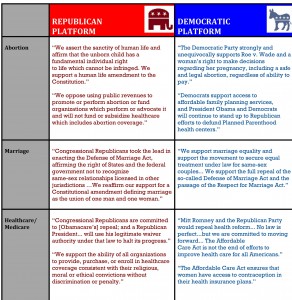 Ah, election season. How I love thee.
Ah, election season. How I love thee.
In the tsunami of allegations and attack ads marking the run-up to November's hotly contested midterm races, it's easy to lose track (and interest) of what the candidates and their political parties actually stand for, and just how much is at stake. Midterm elections generally garner far less attention than presidential contests, leaving a huge segment of eligible voters in America largely uniformed and disinterested about outcomes. Perhaps most consequential in this election is the fate of the U.S. Senate, which Democrats stand to lose to control of.
The question, then, is so what? Are America's two ruling political parties really all that different from each other?
Short answer: yes.
Browse through the official platforms of the Democratic and Republican parties (adopted in 2012), and you'll notice some pretty extreme contrasts in philosophy on everything from taxes to abortion. In these documents, both parties have laid out a set of fundamentally different visions for America and the role government should play in our lives.
